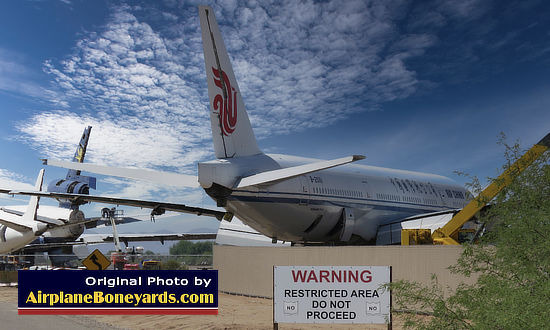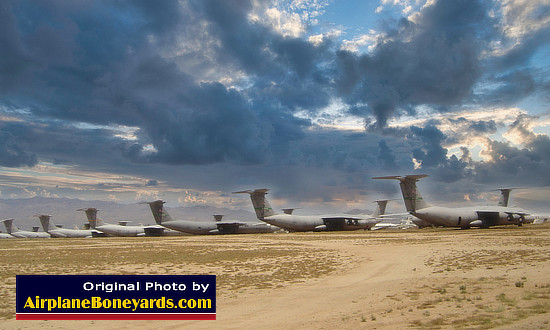
Airplane Boneyards and Storage Facilities
Commercial airliners and military aircraft have limited lifespans. Some are temporarily removed from flying status, and must be stored in a environment that is conducive to preservation. Others are kept as spare parts for flying aircraft.
Eventually, as airframes wear out and economics change, aircraft are either stored temporarily or removed permanently from service and scrapped at an "airplane boneyard".
Commercial Airliner Boneyards and Storage Facilities
Airliner "boneyards" in the U.S. and in Europe serve several functions: temporary storage, maintenance, parts reclamation, and scrapping.
To protect airliners during their storage from wind and sun damage, engines and windows are tightly covered with white, reflective materials. Eventually, all airliners are removed permanently from service and are scrapped for parts and materials.
Even the Boeing 747, the "Queen of the Skies", sometimes meets the boneyard, like the last of the United Airlines 747 fleet ferried to SCLA in Victorville in 2017. And the last Qantas 747 flew to Mojave in July of 2020 for storage.
This website includes coverage of several major storage, maintenance and disposal facilities for commercial airliners, such as those at the Southern California Logistics Airport in Victorville and the Mojave Air and Space Port in the California desert.
Also included are reports on airliners in storage at the Phoenix Goodyear Airport and the Kingman Airport, as well as the Roswell International Air Center in New Mexico. We also provide coverage of boneyards in Europe and Australia.
Updates have been made on our article on the Pinal County Airpark in Arizona.
Military Aircraft Boneyards in the United States
The United States manufactured about 294,000 aircraft for the World War II effort. Once peace was assured, the U.S. military had a huge surplus of aircraft. By the summer of 1945, sales-storage depots, or "aircraft boneyards", were in operation to deal with nearly 120,000 surplus aircraft.
After WWII, military aircraft had three possible fates: 1) sale to a private entity, 2) scrapping, or 3) long-term storage.
If a plane was not sold at boneyards such as those at Kingman AAF, Cal-Aero Field/Ontario, or Walnut Ridge AAF, it was stripped of classified information, sliced up with guillotines, and melted in smelters into ingots. Thousands of military planes had been scrapped by 1947.
Newer aircraft such as the B-29 Superfortress were held in long-term storage for future recall to active duty during the Korean War and the Cold War for use as bombers, aerial tankers and weather reconnaissance.
Today, surplus U.S. military planes are stored in the largest airplane boneyard in the world, operated by the 309th Aerospace Maintenance and Regeneration Group AMARG at Davis-Monthan Air Force Base in Tucson.
List and Maps of Boneyards Around the World
A list and map of major airliner storage boneyards is also provided as well as a review of boneyards in the U.K., Spain, France, Australia and around the world.
Hong Kong Airlines jetliners at the Chateauroux Airport in France - June 17, 2020 (Photo by DELEHELLE Eric) |
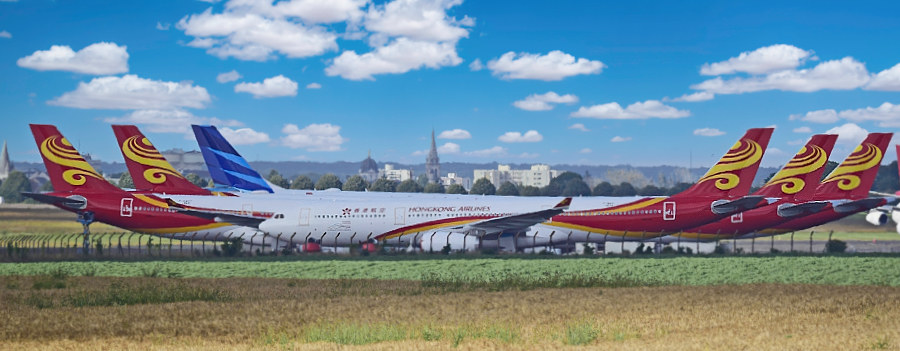 |
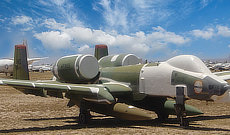
Davis-Monthan AMARG
As Air Force, Navy and Marine planes become obsolete and need to be disposed of, or saved for future return to service, they are stored in the largest airplane boneyard in the world, in the Arizona desert. The storage facility is operated by the 309th Aerospace Maintenance and Regeneration Group AMARG at Davis-Monthan Air Force Base in Tucson.
READ MORE
Airliner Boneyards
Jetliners eventually reach end-of-life due to airframe wear and/or obsolescence. Some jetliners are temporarily taken off flying status, and must be stored in a environment that is conducive to preservation. Others are kept for spare parts for flying aircraft, and eventually scrapped. Most of these airliner boneyards are located in Arizona and California.
READ MORE
Post-WWII Boneyards
Once peace was assured after WWII, the military found itself with a huge surplus of aircraft. Following the war, estimates of the number of excess surplus airplanes ran as high as 150,000. Consideration was given to storing a substantial number of airplanes, but the realization that the expense to store them was too great ... many needed to be sold or scrapped.
READ MORE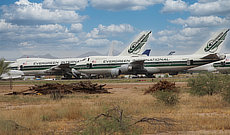
Visiting Boneyards
Virtually all airplane boneyards and storage facilities are limited access sites. Boneyards typically do not allow visitors and do not provide tours. We encourage potential visitors to check with individual sites to learn about access policies and tours, and avoid restricted areas.
READ MORE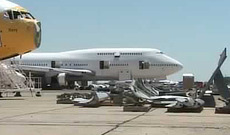
Reclamation & Scrapping
Commercial airliners have limited lifespans. Ultimately, they must be retired from service, stored in airplane boneyards or graveyards, and finally dismantled and scrapped.
READ MORE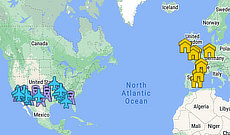
Boneyard Maps
A map is provided showing the commercial airliner boneyards in the U.S. and Europe as well as post-WWII boneyards.
READ MORE
About This SiteThis website is an online resource about the facilities engaged in the storage, reclamation and disassembly of aircraft. We do not own or operate an airplane boneyard, or have an affiliation with any boneyard, the Department of Defense, or any aviation museum. We do not offer tours, and we do not own aircraft or maintain a parts inventory. |
Continued Evolution of This Aviation Website Series
We launched Planes of the Past in 2012, which over time grew into a large site covering a variety of aviation-related topics. In 2015, we split the website into more focused topics based on our viewers' interests. Now we offer the following websites which we welcome you to visit as we expand our content in 2024:
- Airplanes-Online - World War II, the Cold War and modern day airplanes
- AirplaneBoneyards.com - Military and airliner boneyards in the U.S., Europe & Australia (this website)
- AirlinerSpotter.com - Airliner spotting tips, Airbus and Boeing fleets with characteristics, comparisons and photographs
 |
||
 |
 |
 |
